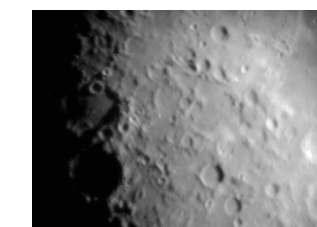
The following movie demonstrates "atmospheric seeing" using images taken 1/2-second apart with a 10-inch aperture telescope and a Nikon Coolpix 990 digital camera. There are 11 images, that repeat in a loop at twice the rate at which they were taken.

The large crater on the middle left is Hipparchus, which is about 73 seconds of arc in diameter. Mars is about 1/4th the diameter of Hipparchus at a typical "opposition" (similar in angular size to the crater at the top of this image that is slightly "cut off" at its top). This quality of "seeing" is typical for an elevation angle of 30 degrees at a sea level site.
If you look carefully you can see that parts of the image move in directions that are uncorrelated with motions at another region. Sometimes a place will appear to magnify, then shrink. Clarity variations (resolution) are the most critical for optical viewing, whereas for astrophotography all the types of distortion produced by atmospheric seeing are important (since image processing normally involves adding several images together).
"Atmospheric seeing" is typically not a problem for "dark sky" objects. It mostly affects planetary and lunar work, since for these objects achieving resolution is far more important than achieving high brightness levels.
"Atmospheric seeing" is caused by non-uniformities of the atmosphere's temperature field. If all atmospheric layers were of uniform temperature, there'd be no "seeing" problems.
Seeing is usually degraded at two altitude regimes: 1) the "planetary
boundary layer," typically from ground level to about 2000 feet, and 2)
near the tropopause, which is at about 36,000 feet (at mid-latitudes) or
52,000 feet in the sub-tropics and tropics (latitudes less than 25 degrees,
usually). The planetary boundary layer (PBL) component of seeing
problems can be greatly reduced by moving your telescope to a high altitude
site, where something vaguely resembling a PBL is much shallower.
But the tropopause component of seeing can only be reduced by flying in
an airplane at altitudes above the tropopause (i.e., as was done by the
Kuiper Airborne Observatory, when it flew out of NASA's Ames Research Center
prior to about 1997). The PBL component of seeing distortions change
greatly with time of day, being worse at sunset and gradually improving
throughout the night, being best just before sunrise, typically.
The tropopause component of seeing does not ahve a time of day dependence,
that I'm aware of, but it does change on timescales of approximately minutes,
hours and days. If the jet stream (located just below the tropopause)
is near your observing site, count on bad seeing. The best seeing
is when a high pressure system is centered over the site. High altitude
winds are light at the center of a "high." If the "high" is off to
one side, and the observing site is located where there's a strong pressure
gradient, then winds are likely to be strong at high altitudes, and possibly
at ground level. Winds are never good for seeing, as layers with
different wind speeds do not always maintain their laminar flow, and vertical
oscillating waves (KH waves) can amplify (and may eventually lead to "clear
air turbulence" - which creates disastrous "seeing").
~~~~~~~~~~~~~~~~~~~~~~~~~~~~~~~~~~~~~~~~~~~~~~~~~~
Copyright B. L. Gary 2001